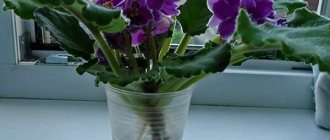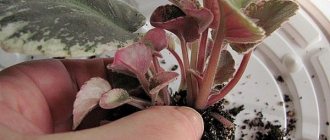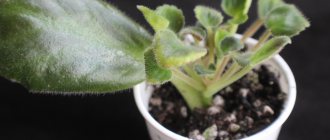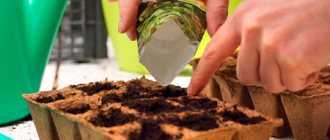Greenhouse / Floriculture
Violets in a greenhouse
Violet is one of the most beloved flowers, grown by most peoples of the world. Caring for them is interesting and very simple. This is an indoor plant. Flowers amaze with many variations, and are of interest to many housewives who collect plants. This article will tell you how to grow violets in greenhouses.
- 1 Varieties of indoor violets 1.1 Types and varieties of violets
- 2.1 Violet propagation
Choosing a variety for planting
Among the varietal variety of viola, the most popular varieties and forms are:
- with spectacular bright colors - single-color, two-color and spotted;
- unpretentious in care and resistant to diseases.
Wittrock violet has many shades.
Based on these preferences, it is recommended to choose varieties for growing viola seedlings in a greenhouse:
- "Alpensee" - blooms with dark purple large flowers with a yellow eye - the contrasting petals of this flower have a characteristic mark in the form of cilia.
- “F1 Cristal Bowl White” - large flowers - about 10 cm in diameter, white with a mark in the form of a yellow eye and a wavy edge of the petals.
- "Delta Pure Deep Orange" - flowers of orange color without o - yellow flowers with a diameter of over 6 cm, have a mark in the form of a purple spot on the lower petal.
- “Majestic Giant II Scherry” - flowers about 10 cm in size, pink-cherry in color with a dark cherry spot in the center, may have a yellow rim.
- "Maxim Marina" - purple-white flowers with a purple spot in the center and a yellow eye.
In addition, the varieties “Pure White”, “Reingold”, “Skyline Orange”, “Tangenne”, “Four Seasons”, “Lemon Violets”, “Rippling Waters” have excellent decorative qualities.
Most often, Wittrock violet has many shades and is used to decorate flower beds.
Violets in the Greenhouse: Growing Instructions
Violets in a greenhouse
Violet is one of the most beloved flowers, grown by most peoples of the world. Caring for them is interesting and very simple. This is an indoor plant. Flowers amaze with many variations, and are of interest to many housewives who collect plants. This article will tell you how to grow violets in greenhouses.
How to plant Wittrock violet
Particularly valuable Wittrock violets can be propagated in greenhouse conditions by layering and cuttings, but the most popular method of propagating this flower is the seed method.
To grow Wittrock violets, it is recommended to choose fertilized loamy soil with a neutral reaction, which should be pre-steamed or treated with a solution of potassium permanganate and well moistened. You can also plant seedlings in a soil mixture consisting of equal proportions of garden soil, humus and peat. There are 2 common methods of planting violas - deep into the ground and surface.
Germination of Wittrock violet seeds
- In the greenhouse, viola seeds are sown from January to March; in addition, autumn sowing of seeds is also practiced. Seeds sown in furrows, at a distance of 1-2 cm from each other, should be sprinkled with peat, sand or soil on top, and moistened with a spray bottle. The width between the furrow rows is 1 cm. Cover with polyethylene. Twice a day, the film should be opened for 10 minutes to remove any condensation that has formed. During this period, the temperature inside the greenhouse is 22-25° C. After 1-2 weeks, shoots will appear.
- Another way to effectively plant viola seeds is to sow them superficially, without planting them in the ground. To do this, spread violet seeds 2 cm apart from each other on the surface of well-moistened soil. Cover with dark film, which should be opened slightly every day to remove condensation. With this sowing method, seedlings appear a little earlier.
Attention! As experiments in cultivating Wittrock violets show, it is best to grow its seedlings using peat tablets. They are rich in nutrients, retain heat well, and do not retain water. Thanks to all these qualities, peat tablets provide a high degree of survival of viola seedlings. To grow seeds, the tablets should be kept in water until they swell, and then the seeds are placed on top of them and lightly covered with soil.
Winter planting of Wittrock violets blooms in late May-early June, if the seeds are sown in March, flowers will appear at the end of summer, summer planting of seeds ensures abundant flowering of the viola in the spring.
Violet shoots
Features of indoor greenhouse
As you know, plants love light, so it would be appropriate to make the side walls from glass. It is also better to place the structure in a well-lit area and, if necessary, additionally install fluorescent lamps.
Moisture is an equally important factor, so there should always be vessels with water in our greenhouse. But this rule does not apply to cacti, because they love dry air. In general, the climate in the greenhouse is selected according to the tropical or subtropical type of plant.
The heat in the greenhouse can be maintained by electric heating with the installation of a relay to automatically maintain a certain temperature. Also, do not forget about the attractive appearance of the design. It should be light, without a lot of overlap on the roof and wall, and the shelves should be made of glass on light brackets.
How to grow seedlings
In the first days after emergence, it is recommended to continue covering the seedlings with film, opening it at least 2 times a day, gradually increasing the duration of ventilation. After a week, the film can be finally removed. Care during this period consists of regular watering, without waterlogging the soil. As soon as the seedlings have 2 true leaves, they can be picked.
Attention! Wittrock's violet tolerates replanting well, so even if the seedling's root system is damaged, it will still take root if, when replanting, it is deepened to the cotyledon leaves.
Deep planting of seedlings promotes the formation of compact bushes and a powerful root system. To increase the bushiness of the viola, it is recommended to pinch it after the 3rd leaf appears.
After the third leaf appears, pinch the violet bushes
Caring for viola involves frequent watering, since it cannot tolerate even short-term drying out of the soil; in addition, it needs loosening and weeding. With the beginning of flowering, the violet should be provided with regular fertilizing with universal fertilizer, every 2 weeks, for example, with a solution of the drug "Agricola-7".
Violets grow quickly, forming compact bushes 10-25 cm high. They bloom profusely - for several months, to prolong flowering, it is recommended to constantly trim wilted buds and elongated shoots.
Attention! If the Wittrock violet begins to bloom less, its bushes can be rejuvenated and stimulated to bloom if they are cut to a height of 12 cm, well watered and fed.
Wittrock violet needs to be watered frequently and abundantly.
How to grow an adult plant from a baby?
You can raise children yourself or trust store specialists:
- if you grow the babies yourself , then when they appear on the leaf, do not rush to separate them. This is done when the rosette reaches a size of 4-5 cm and has a pair of leaves;
- If you bought a baby , then do not rush to transplant it into your pot. Give her time to get used to the ground. And after 2 weeks, replant.
Plants in the stage between baby and adult are called “starters” . At this stage, the plant is transplanted into fresh soil. At the same time, all the lower, small leaves are torn off, this contributes to the formation of a beautiful and regular rosette.
Stages of violet development.
There are several important points on how to grow a beautiful rosette:
- if the “sterter” is constantly flooded, an irregular rosette will form, the leaves will bend, and the middle will become denser;
- At the stage of rosette formation, lighting plays a very important role. In order for it to be of the correct shape, the pot with the plant is periodically turned towards the light;
- the first buds and stepsons that appear are removed, the violet is not yet ready for full flowering;
- with the further growth of Saintpaulia, temperature plays a role in the formation of a correct rosette.
Within 7-9 months after the baby has separated, you will have a fully formed plant.
Growing problems
Despite its unpretentiousness, Wittrock violet is susceptible to some fungal diseases:
- spotting. A fungal disease that affects the foliage of viola, forming dark spots on it. You can get rid of the disease by spraying with antifungal drugs and isolating the affected plants;
- root rot. Plants affected by this fungal disease should be destroyed, and all others should be treated with a fungicide;
- downy mildew. A fungal disease that affects viola as a result of violations of growing technology: evening watering, failure to maintain temperature conditions, water getting on the foliage. You can get rid of the disease using fungicides;
- blackleg. A fungal disease that develops, like downy mildew, as a result of violations of agricultural practices. Affected plants should be removed, the rest should be sprayed with a fungicide or a soda-soap solution.
Growing Wittrock violets in closed ground conditions ensures the production of profusely flowering plants from spring to autumn. Following basic agricultural practices will make growing them simple and enjoyable.
Growing Wittrock violets - video
Signs on whether it is possible to grow violets at home
There are many signs about how violet affects a person’s destiny. For a superstitious person, choosing the right flower is not always quite easy. There are always both positive and negative signs.
Good signs:
- prevent negative energy from entering the house;
- red violet attracts money to the house;
- purple helps calm the nerves;
- expel ants from the home.
Bad omens:
- an unmarried girl may be left without a groom;
- survives from the men's house;
- causes quarrels and scandals in the family;
- takes away a person’s energy;
- violet-grave flower. Attracts misfortunes and troubles.
It depends on how much we believe in this or that sign whether it is worth buying a violet for the house or not.
Wittrock violet - photo
Pests and diseases of violets
If not cared for properly, flowers become too fragile and often get sick.
Most often these can be:
- Rot. The discovery of traces of rot on the leaves indicates damage to the root system. Such damage can be caused by parasites or improper watering. Cutting off the upper unaffected leaves and rooting them in a new substrate will help save the violet;
- Spotting. In the absence of traces of parasites, spots may appear from sunlight or liquid ingress during watering. If there are a small number of damaged leaves, they can be removed. Shade the flower in bright sun, and most importantly, water it carefully;
- Powdery mildew. This type of infection is fungal. In this case, a white coating appears on the stems and leaves of the flower, and the plant begins to hurt. To defeat the fungus, it helps to isolate the flower from other indoor plants, and then treat it with a special preparation, such as Topaz. This disease often appears at low temperatures, high humidity, or excess dust on the leaves of the flower;
- Late blight. This fungal disease causes rotting of the leaves and roots of the flower. The reason is high humidity. To save the plant, the cutting must be transplanted into a separate pot. You can cut off the top of the flower and replant it too;
- Sciarides or fungus gnats that actively damage and eat violet leaves. They should be controlled with insecticides.
Advice: To kill insects with drugs, it is necessary to treat the soil and use aerosols. The procedure should be repeated until all the flies disappear.
Plant diseases can be prevented by inspecting them daily for any damage or stains. Violet is a favorite plant of gardeners, requiring some care. This is a delicate and wonderful flower for growing at home and in greenhouses.
Using greenhouses when propagating Saintpaulias
Moderator: Floriana
Using greenhouses when propagating Saintpaulias
Posted by Inbed » 19 Dec 2009, 15:39
Using greenhouses when propagating Saintpaulias
My greenhouse is a cake pan with a high transparent lid. There are two holes made in it (a pencil or pen will fit through). Our bakery makes them, apparently so that the cakes don’t suffocate. Therefore, air had to flow more or less.
Using greenhouses when propagating Saintpaulias
Post by Nadezhda 77 » Jan 25, 2010, 8:10 pm
Using greenhouses when propagating Saintpaulias
Post by tanchela » Jan 25, 2010, 9:35 pm
Using greenhouses when propagating Saintpaulias
Post by Gulnara » May 14, 2010, 03:48 pm
The other day I had to return to the old method of rooting Saintpaulia leaves. Not only does it save space, you also don’t have to water it
And this is what they look like with children.
Using greenhouses when propagating Saintpaulias
Post by AnnaT » May 14, 2010, 21:52
Using greenhouses when propagating Saintpaulias
Post by Gulnara » May 14, 2010, 11:09 pm
Using greenhouses when propagating Saintpaulias
Post by Eli » May 14, 2010, 11:12 pm
Using greenhouses when propagating Saintpaulias
Post by Gulnara » May 14, 2010, 11:21 pm
Using greenhouses when propagating Saintpaulias
Post by Eli » May 14, 2010, 11:39 pm
Using greenhouses when propagating Saintpaulias
Post by Gulnara » May 14, 2010, 11:45 pm
Not certainly in that way. When the babies become quite large, they are separated from the mother’s leaf one at a time and very, very carefully so as not to damage the leaves of other babies. In this case, the mother sheet is not removed from the cup! This operation will be crowned with success if initially the leaf is not planted in the ground, but literally placed on the ground. Then it will be easy to get the kids out. And after 2 weeks this leaf gives rise to a second wave of babies and even a third, if you are careful with the leaf and its roots.
I found this photo from the archive
As soon as I notice that the baby has gone, I immediately take the glass out of the bag. I would like to note that the humidity in the bag is equal to the humidity where I place them. So that there is no stress for young children. And those leaves that were planted directly in a bare bag with a lock, you still have to tinker with them (carefully transfer them either into a glass or into a wide bowl, but in a heap)
Using greenhouses when propagating Saintpaulias
Post by Gulnara » May 15, 2010, 00:05
I don't use lamps because last year they were of no use. For the experiment, half of the children were illuminated with a lamp, while the others sat only in natural lighting. As a result, no one overtook anyone in development. I've been experimenting with violets for now. I'm not so good with my side either. Southwest. The sun shines through the windows from one o'clock in the afternoon until the last ray of light. Everything stands literally 1.5 meters from the window and on the windowsill, and I cover the windows with slats from blinds. In such mini-greenhouses, roots grow faster, according to my observations.
They also develop well in the cake maker, but a little slower.
And for lack of space I had to put them in bags and hang them up.
Using greenhouses when propagating Saintpaulias
Post by ukka-3501 » May 15, 2010, 00:10
Do you need to make holes in the bottom of these mini greenhouses?
I’m just trying it, this is my first experience, I planted it like yours in a large glass without holes and covered it with cling film, we’ll wait.
Using greenhouses when propagating Saintpaulias
Post by Gulnara » May 15, 2010, 00:15
All my cups come with holes, because in the future I will water them all from a common tray at once, but this is only if my children are healthy. But for those who come to me as newcomers, be it a leaf or a baby, I water them individually and in a glass without holes, and separately from everyone else. And for the leaves themselves, which sit in such greenhouses, it doesn’t matter whether they have holes in the cups or not. You don’t need to ventilate them, well, unless, of course, you overdo it with water.
Here are my greenhouses for violets. I used all the cells I found and wrapped them in self-adhesive film.
Using greenhouses when propagating Saintpaulias
Post by Grin25 » Jan 18, 2011, 11:46 am
Using greenhouses when propagating Saintpaulias
Post by Olga Rasputina » Jan 18, 2011, 12:17 pm
Using greenhouses when propagating Saintpaulias
Post by Svyatoslav » Jan 18, 2011, 01:41 pm
Using greenhouses when propagating Saintpaulias
Post by AEA » Jan 18, 2011, 1:49 p.m.
Using greenhouses when propagating Saintpaulias
Post by Grin25 » Jan 18, 2011, 2:23 pm
Using greenhouses when propagating Saintpaulias
Post by Svyatoslav » Jan 18, 2011, 2:46 pm
Using greenhouses when propagating Saintpaulias
Post by Filuna » Jan 18, 2011, 05:41 pm











